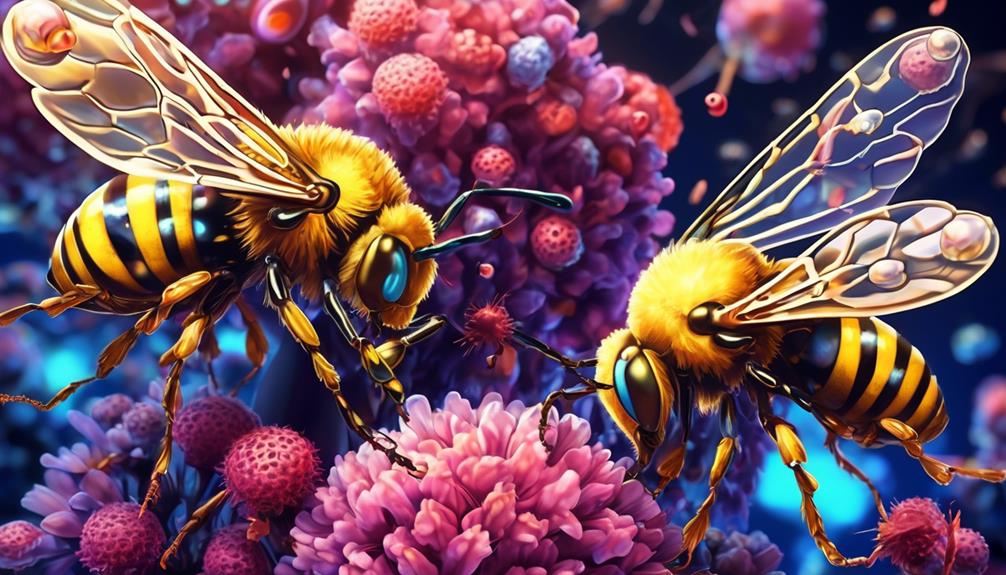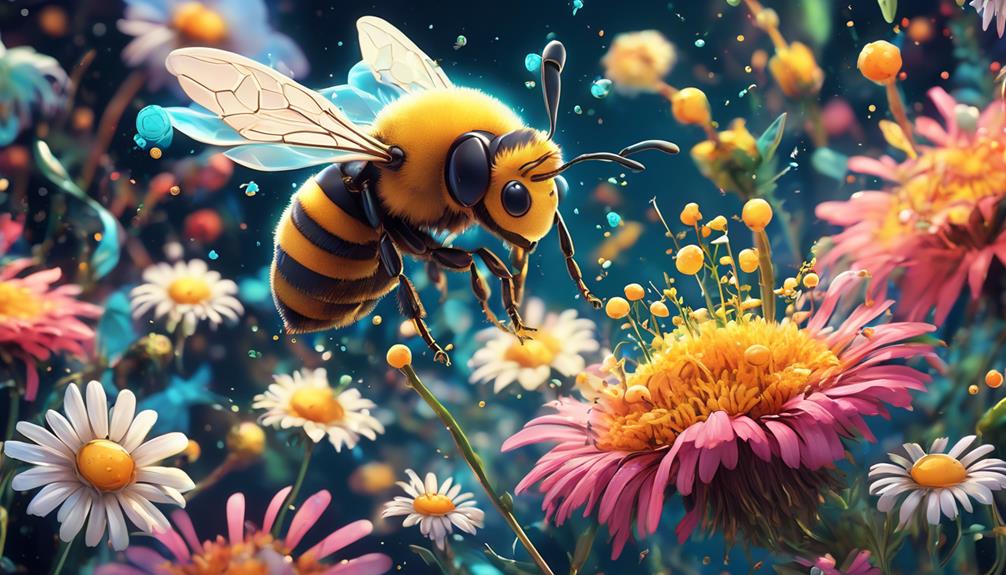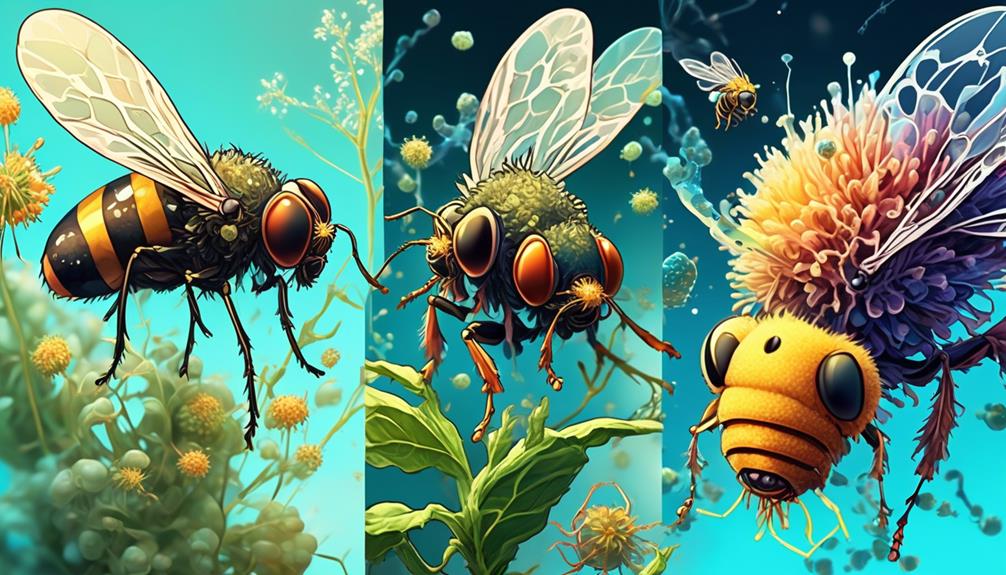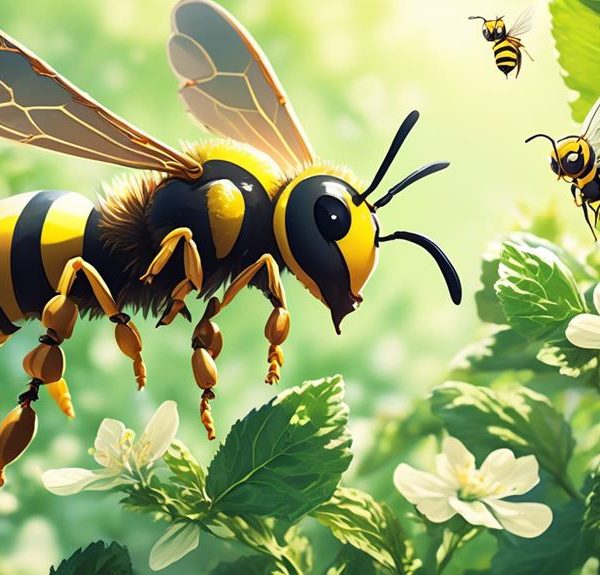Navigate the fascinating world of bees and flies to uncover if both insects carry germs alike, in this intriguing exploration into insect hygiene.

Do Bees Carry Germs Like Flies?
Just as bees are symbols of industriousness and flies are associated with decay, so too are their interactions with germs fundamentally different.
You've likely noticed the pesky fly, seemingly obsessed with dirty environments, and contrasted it with the bee, diligently collecting nectar from blossoming flowers.
It's a common perception that flies are carriers of disease, but what about bees? Do they, in their ceaseless quest for nectar, carry germs the same way flies do?
As someone interested in the natural world's intricacies, this question might have crossed your mind, prompting a deeper exploration into the hygiene habits of these buzzing creatures.
Key Takeaways
- Bees can act as vectors for pathogens, potentially carrying them from one place to another.
- Bees have evolved hygienic practices such as grooming and producing antimicrobial substances to limit disease spread.
- Bees are generally cleaner creatures compared to flies, which frequently visit decaying organic matter and accumulate a wide variety of germs.
- Bees generally pose minimal health risks to humans and their behaviors help reduce pathogen transmission.
Understanding Germ Transmission in Insects

To delve into the realm of germ transmission in insects, it's essential to grasp that just like flies, bees can also act as vectors, potentially carrying pathogens from one place to another. You might wonder how this happens. When a bee lands on a flower, bacteria and viruses on the flower can latch onto the bee's body. As the bee travels to the next flower, it can inadvertently deposit these pathogens, spreading them around.
You also need to understand that not all germs carried by bees are harmful. Some microbes play a vital role in the pollination process, aiding in the growth and development of certain plants. Yet, others can cause diseases in plants, and even in bees themselves.
It's crucial to note that the transmission of germs in bees isn't as straightforward as it might seem. Factors like the bee's immune system, the type and quantity of germs, and environmental conditions can influence this process. In essence, the study of germ transmission in bees is a complex scientific field that requires a detailed and analytical approach.
Bees and Their Hygienic Practices

While considering the complex dynamics of germ transmission in bees, it's also worth exploring their intrinsic hygienic practices that play a pivotal role in this process. Unlike flies, bees have evolved a series of behaviors to ensure the cleanliness of their colonies. These actions, known as social immunity, are vital in reducing the transmission of harmful pathogens.
In your investigation, you'll discover bees demonstrate an impressive array of sanitary behaviors. They meticulously clean their hives, removing any potentially harmful debris or dead bees that could harbor disease. Additionally, bees exhibit grooming behavior, where they use their legs to scrape off mites or other parasites. This not only keeps individual bees healthy but also minimizes the spread of pathogens within the hive.
Moreover, bees possess the ability to produce antimicrobial substances. These include propolis, a resinous compound bees gather from tree buds, known for its potent antibacterial properties. They coat their hive with this substance, creating a germ-free environment.
This focus on cleanliness highlights the stark contrast between bees and flies regarding germ transmission. Understanding bees' hygienic practices provides insight into their lower propensity for disease spread compared to flies.
Comparing Flies and Bees: Pathogen Carriers?

Now, let's delve into the comparison between bees and flies as carriers of pathogens, providing a comprehensive analysis of their roles in germ transmission. It's crucial to remember that both insects interact with their environment differently, which directly impacts the number and types of pathogens they carry.
Flies, particularly houseflies, are notorious for their poor hygiene. They frequently visit decaying organic matter, garbage, and feces, accumulating a wide variety of germs on their bodies. They can pick up and transmit diseases such as cholera, dysentery, and typhoid, making them significant public health pests.
On the other hand, bees are generally cleaner creatures. They've grooming behaviors that help remove foreign particles, including potential pathogens, from their bodies. They also produce antimicrobial substances, like propolis, which limit the spread of diseases within their colonies. However, they aren't entirely germ-free. They can harbor bacteria and fungi harmful to humans, but the risk of transmission is significantly lower than with flies.
Impact of Bees on Human Health

Despite their potential to harbor harmful bacteria and fungi, bees generally pose minimal health risks to humans, largely due to their meticulous grooming behaviors and production of antimicrobial substances. These behaviors help to reduce the likelihood of transmitting pathogens. They're not like flies that carry and spread diseases due to their feeding and breeding habits.
However, bees aren't entirely harmless. You've likely heard of bee sting allergies, anaphylactic reactions that can be life-threatening. Bee venom contains proteins that can cause such reactions in susceptible individuals. But it's not all bad news. Bee venom is also used therapeutically in apitherapy for conditions like arthritis and multiple sclerosis—showing a dual-faced impact on human health.
Moreover, bees play a crucial role in pollinating our food crops. Without them, our food system would suffer, impacting human nutrition and health indirectly. In contrast, bees can also transmit spores of the bacterium Paenibacillus larvae, causing a fatal disease in bee larvae impacting bee populations, and thus, potentially our food supply.
Ways to Coexist Safely With Bees

Understanding how to coexist safely with bees is crucial, as it not only decreases the chances of dangerous sting incidents, but also supports the vital role bees play in our ecosystem. As pollinators, bees contribute significantly to the biodiversity of our environment. Therefore, it's important to respect their space and not provoke them.
The first step to coexistence is understanding their behavior. Bees are typically non-aggressive unless they feel threatened. Avoiding quick movements, wearing bright or floral clothing, or consuming sweet foods and beverages in their presence can help minimize the risk of stings.
Next, consider bee-friendly gardening. Planting native wildflowers, shrubs and trees can provide bees with food and habitat. Avoiding chemical pesticides is also key, as these can harm bees and other beneficial insects.
Lastly, if you find a bee nest on your property, don't attempt to remove it yourself. Contact a professional pest control or a local beekeeper who can relocate the hive without harming the bees. They're experts in handling bees and can do so without causing unnecessary stress to the colony.
Frequently Asked Questions
What Is the Lifespan of a Bee and Does Its Age Impact Its Ability to Carry Germs?
Yes, a bee's lifespan can impact its ability to carry germs. Worker bees live for about six weeks. However, during this short lifespan, their immune system weakens, making them more susceptible to germs.
But unlike flies, bees aren't known for spreading diseases. They're generally clean insects, but that doesn't mean they can't carry germs. It's less about their age and more about their exposure to harmful bacteria.
Can the Honey Produced by Bees Be Contaminated by the Germs They Carry?
Yes, bees can potentially contaminate honey with germs they carry. However, it's vital to note that honey's natural properties often kill bacteria. Honey is acidic and low in moisture, making it a hostile environment for many germs. Additionally, bees add an enzyme to honey that produces hydrogen peroxide, a known antibacterial agent.
Does the Type of Flower a Bee Pollinates Affect the Type of Germs It Carries?
Yes, the type of flower a bee pollinates can affect the germs it carries. Each flower species hosts unique microbes, which can hitch a ride on bees.
As you know, bees are nature's pollinators and they hop from flower to flower, gathering nectar. This journey exposes them to a variety of bacteria and fungi, potentially affecting their microbiome.
However, bees also have immune systems that can combat harmful microorganisms.
Are There Any Specific Diseases Known to Be Spread by Bees?
Yes, there are diseases spread by bees.
As a beekeeper, you should be aware of American Foulbrood, a bacterial disease that's lethal to bee larvae. It's spread through spores that bees carry between hives.
Nosema disease is another concern; it's a fungal infection that harms adult bees' digestive systems.
Both diseases can devastate a colony, so it's vital to monitor your hives regularly for signs of illness.
Can the Use of Pesticides on Plants Affect the Germs Carried by Bees?
Yes, pesticides can indeed impact the microbes bees carry. When you spray pesticides on plants, they don't just kill insects, they can also alter the microbial communities within bees.
This can disrupt their gut bacteria, which are crucial for their health and immunity. So, you're not just affecting the bees, but potentially the quality of their pollination and the health of the plants they visit too.
Conclusion
So, do bees carry germs like flies?
Not quite. Bees uphold stringent hygienic practices, unlike flies that are notorious pathogen carriers.
Bees have minimal impact on human health and rarely spread diseases.
It's essential, though, to coexist safely with bees, respecting their role in our ecosystem.
Let's understand and appreciate these industrious pollinators, recognizing their importance rather than associating them with disease.



